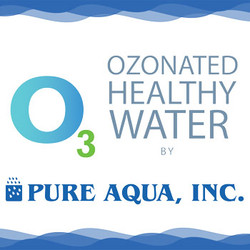Water Treatment by Ozonation
Posted by Pure Aqua, Inc. on Jun 10th 2013
Pure Aqua, Inc. designs and assemble complete ozone generators and ozone water treatment systems for commercial, residential and industrial water treatment purposes. Applications range from treating swimming pool water to food processing water and bottling applications.
Pure Aqua, Inc. designs and assemble complete ozone generators and ozone water treatment systems for commercial, residential and industrial water treatment purposes. Applications range from treating swimming pool water to food processing water and bottling applications.
Ozonation
Ozone is a strong oxidizer and can be particularly effective for water and waste water treatment with less than 1% organic content. It is sometimes used as a pretreatment method, or to disinfect wastewater after biological treatment. It oxidizes a wide range of organics, can destroy cyanide wastes and phenolic compounds, and is faster acting than alkaline chlorination. And, unlike chlorine, ozone doesn't generate toxic ions in the oxidation process.
Ozone is the triatomic form of oxygen formed naturally during lightning strikes and anytime an electric arc is formed. It is a very unstable compound and must be produced at the same time it is needed, usually by ultraviolet excitation and corona discharge. It isn't effective in treating slurries, sludges, solids, organic solvents, or tars.
Before use, consider the possibility that ozone will oxidize other stream components that didn't need treatment. Excess ozone, (that is, ozone not consumed in the reaction) must be catalytically decomposed since release isn't permitted
Ozone Water Treatment Systems
Ozonation has recently gained popularity as a treatment alternative in the United States after regulatory agencies placed restrictions on the disinfection by-products, especially levels of tri-halomethane (THM).
Ozonation is an established and proven disinfection alternative as well as a peroxidant for the control of THM precursors. It also has the benefits of:
- Oxidation and volatilization of organics
- Control of algae and associated compounds
- Destabilization (microflocculation) of certain types of turbidity
- Removal of color-causing compounds
- Oxidation of iron and manganese
- Very short disinfection times
- Partial oxidation of organics for subsequent removal by microorganisms.
Ozone Generator Selection
Ozone is generated by passing a high voltage alternating current (6-20 kV) across a dielectric discharge gap through which oxygen gas is injected. Setting aside the sales pitches from manufacturers, most practical generators are either low (50-60 Hz) or medium (200-1000 Hz) frequency. Medium frequency generators are generally considered better performers. It is often helpful to contact Pure Aqua in similar applications to finalize the selection of an ozone generator.
 ENGLISH
ENGLISH ESPAÑOL
ESPAÑOL العربية
العربية PORTUGUÉS
PORTUGUÉS FRANÇAIS
FRANÇAIS

